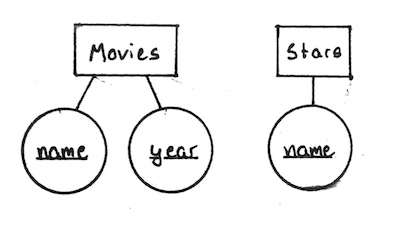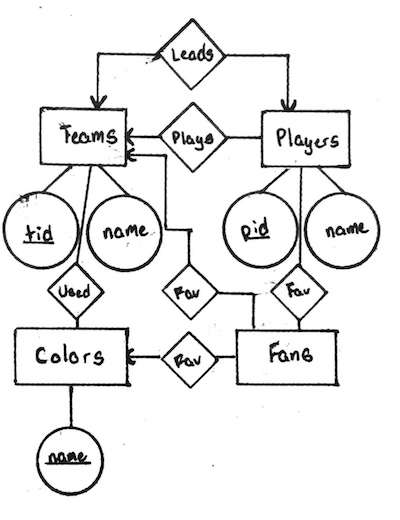Entity Relationship Model¶
definition: The Entity Relationship Model is a notation for expressing database designs.
In the database both entities and relationships will be translated to relations (tables).
Example¶
We can represent a database for movies as follows,
In this diagram,
- Squares represent entities.
- Circles represent attributes.
- Diamonds represent relations.
- Arrows represent a singular relations.
So one studio owns many movies.
Keys¶
definition: A key is an attribute, or a set of attributes, such that no two entities have the same key.
In Entity-Relationship diagrams we underline the keys,

Surrogate Keys¶
definition: A surrogate key is a unique identifier which only serves to be the key for an entity. For example a student number or Social Insurance Number (SIN) is a surrogate key.
Rules¶
An entity set should satisfy one of the following
- It’s more then the name of something, i.e., it has a non-key attribute.
- It’s the “many” side in a relationship.
Example¶
Give an E/R diagram for a database recording information about teams, players, and their fans, including:
- For each team, its name, its players, its team captain (one of its players), and the colors of its uniform.
- For each player, his/her name.
- For each fan, his/her name, favorite teams, favorite players, and favorite color.
Solution¶

Subclasses¶
definition: Sometimes in an entity set or class you have have different types of that entity set, subclasses.
Weak Entity Sets¶
definition: An entity set is said to be “weak” if we need to follow one or more many-to-one relationships to uniquely identify the entity set.
A surrogate key can be used to avoid creating weak entity sets.
Example¶
For football players name and number are not enough to identify them (since two players could have the same name and the same player number), so require the teams name, related by plays-on to uniquely identify them.
